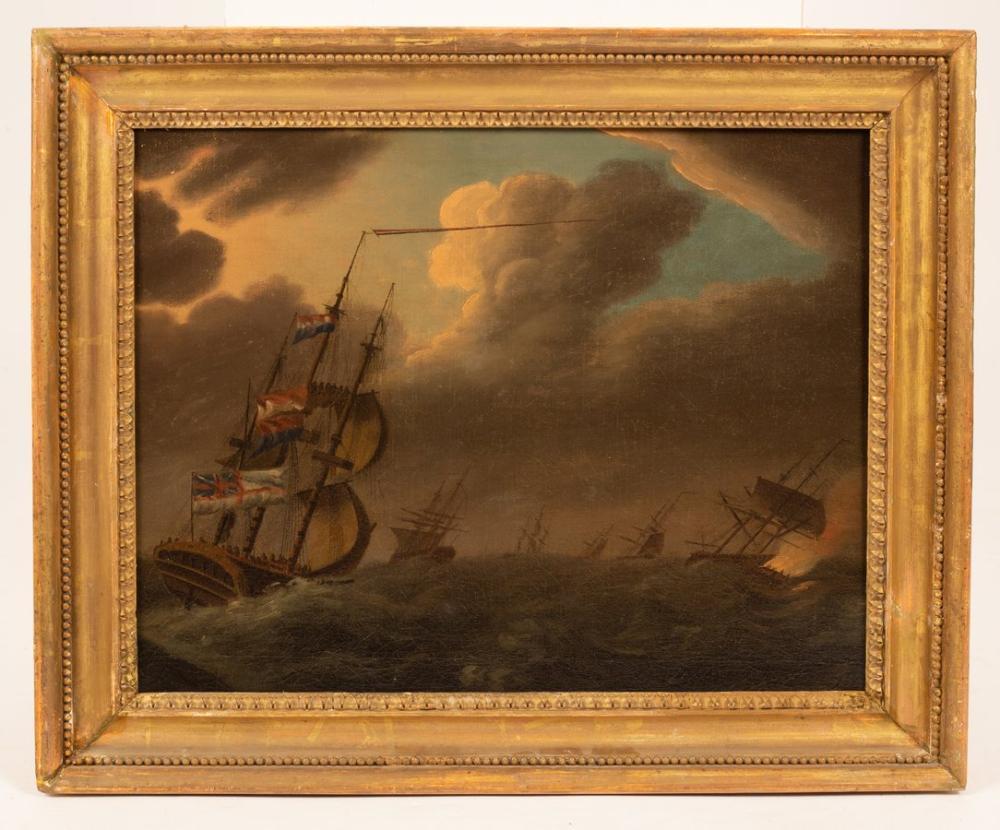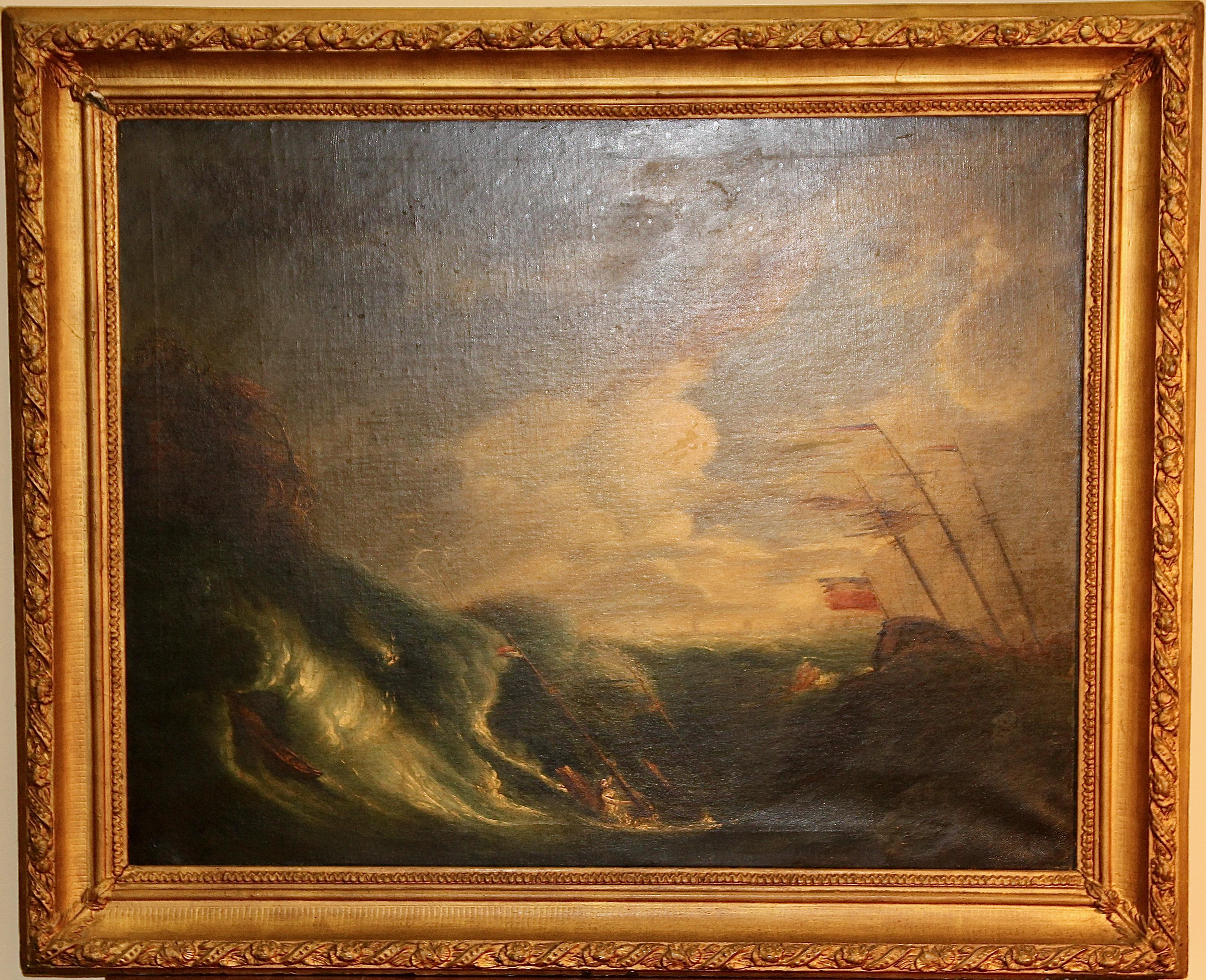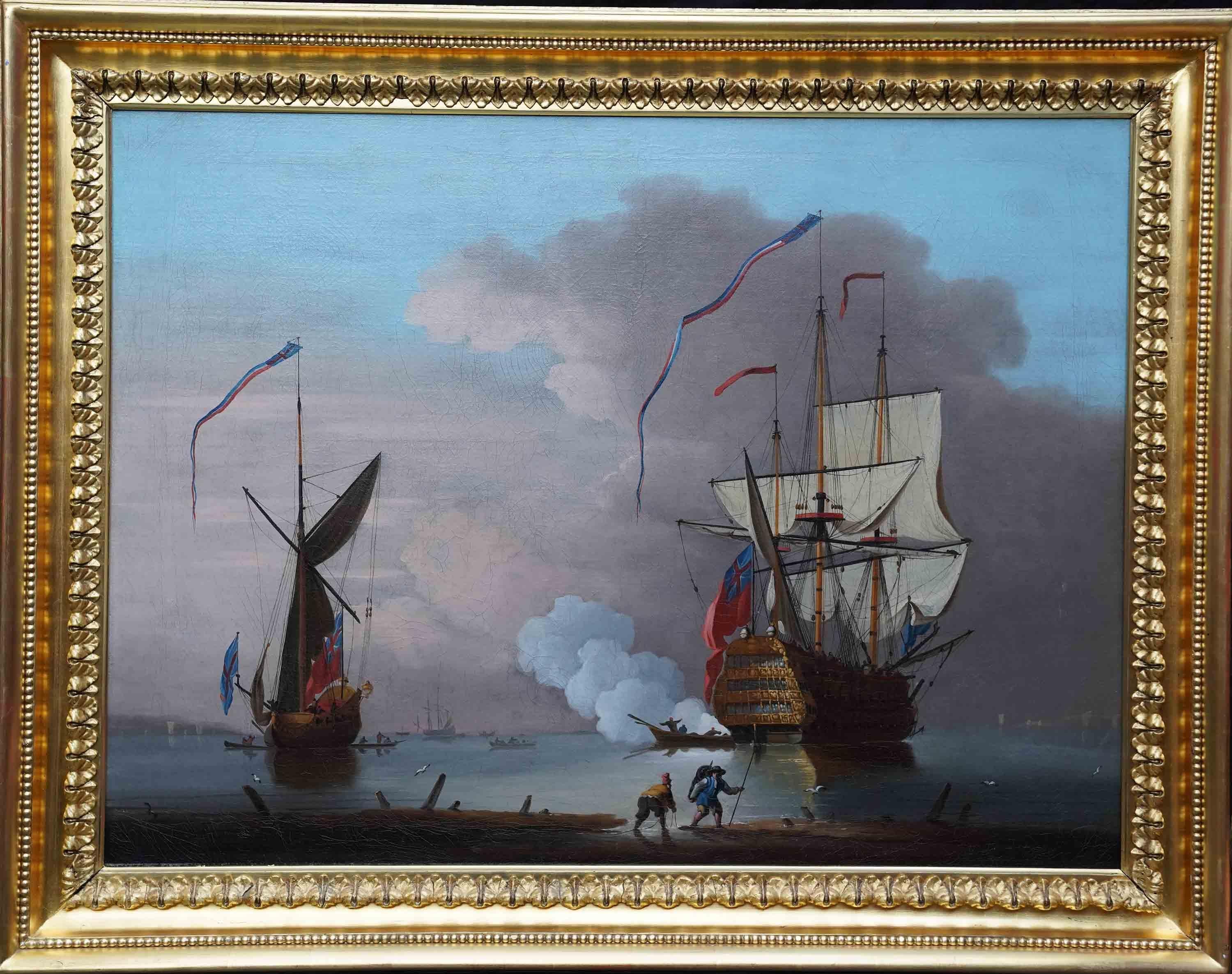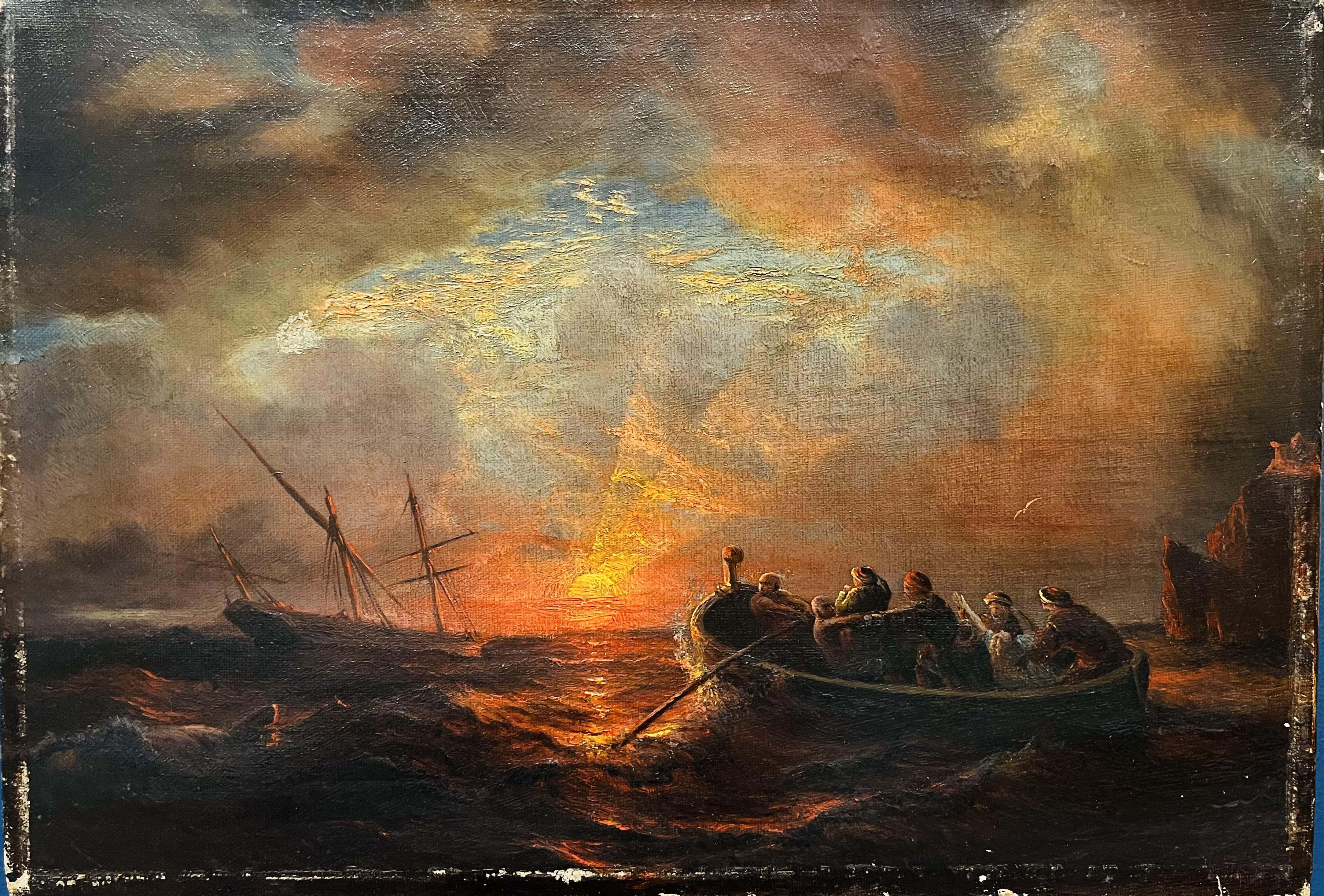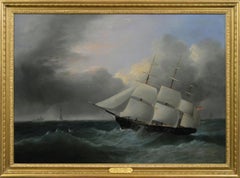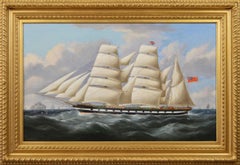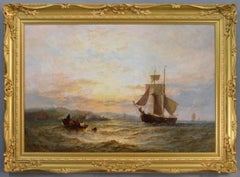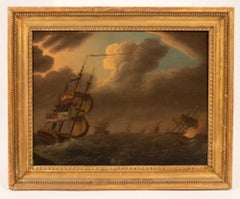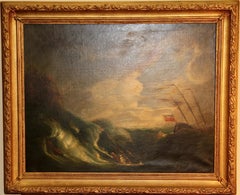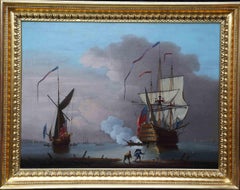Items Similar to 18th Century marine oil painting of a ship on fire
Want more images or videos?
Request additional images or videos from the seller
1 of 16
18th Century marine oil painting of a ship on fireC1760
C1760
$9,634.91
£7,000
€8,205.13
CA$13,153.49
A$14,632.71
CHF 7,670.65
MX$178,808.20
NOK 97,676.19
SEK 91,948.62
DKK 61,248.17
Shipping
Retrieving quote...The 1stDibs Promise:
Authenticity Guarantee,
Money-Back Guarantee,
24-Hour Cancellation
About the Item
Circle of Dominic Serres
British, (1722-1793)
Attack of the Fire Ships
Oil on canvas, indistinctly signed and dated 176(1)?
Image size: 23.5 inches x 39.25 inches
Size including frame: 30.25 inches x 46 inches
A dramatic night time seascape scene of a ship on fire, circle of Dominic Serres. A naval Man-of-War can be seen ablaze off a cliff edged shore as several rowing boats full of sailors flee the scene. To the far right, a number of smaller ships are also depicted on fire. Another Man-of-War is shown waiting at a safe distance ahead of the rest of the fleet to the right. The landscape appears similar to the Quebec promontory and the painting could well be a depiction of the French fire ship attack on the English fleet off Quebec on 28 June, 1759 which took place during the Seven Years War. The painting has been executed by an artist of great ability who has been influenced by Dominic Serres. Serres enjoyed painting ships at night and painted a number of scenes featuring fire ship attacks and ships alight. Two examples depicting the attacks at Quebec can be seen in the National Maritime Museum.
Dominic Serres was born in Auch in Gascony, France. After travelling to Spain he became ship’s captain but was captured by the British navy towards the end of the 1740’s. He eventually settled in London around 1758 and studied art in Northamptonshire and London, where he was tutored by Charles Brooking for a time. He married Mary Caldicutt and three of their children John Thomas Serres (1759-1825), Augusta Charlotte Serres (b1761) and Dominic Michael Serres (1763-1823) also became artists.
His experience at sea inspired his subject matter and the vast majority of his works were marine scenes usually featuring naval ships. He began working from a studio in London Bridge producing seascapes for his nautical clientele which he sold from his own premises. However, it wasn’t until the height of the Seven Years’ War (1756-1763) between England and France that he achieved wider recognition. Public interest in the British naval successes created an appetite for paintings that depicted these historical events. Serres found himself in great demand and was commissioned to produce a series of paintings to document the war. Later on, he also documented scenes from the American Revolutionary War.
Serres began exhibiting at the Society of Arts Exhibitions in 1761 and was one of the founding members of the Royal Academy which began in 1768, exhibiting there over many years. He also acted as their librarian in his final years. He secured many wealthy patrons throughout his career and in 1780 he became Marine Painter to King George III. He often travelled around England sketching vessels at sea and along the coast gathering topographical material. He lived for many years at Warwick Street, Golden Square, London but also kept a studio at 1 St Georges Row, Oxford Turnpike with his children. Serres died on 6th November, 1793 and was buried in St Marylebone Old Church.
Examples of his work are held by the Bradford Museum, Cotswold & Ipswich Museum, National Maritime Museum, National Trust, Shipley Art Gallery and the V & A.
Presentation: The painting is housed in a period gilt frame which is in excellent condition.
Condition: As with all of our original antique oil paintings, this work is offered in ready to hang gallery condition, having just been professionally cleaned, restored and revarnished.
© Benton Fine Art
- Creation Year:C1760
- Dimensions:Height: 30.25 in (76.84 cm)Width: 46 in (116.84 cm)Depth: 3 in (7.62 cm)
- Medium:
- Circle Of:Dominic Serres (1722 - 1793, French)
- Period:
- Condition:
- Gallery Location:Nr Broadway, GB
- Reference Number:1stDibs: LU156215438952
About the Seller
5.0
Platinum Seller
Premium sellers with a 4.7+ rating and 24-hour response times
Established in 1972
1stDibs seller since 2015
338 sales on 1stDibs
Typical response time: <1 hour
Associations
The British Antique Dealers' AssociationLAPADA - The Association of Arts & Antiques DealersInternational Confederation of Art and Antique Dealers' Associations
- ShippingRetrieving quote...Shipping from: Nr Broadway, United Kingdom
- Return Policy
Authenticity Guarantee
In the unlikely event there’s an issue with an item’s authenticity, contact us within 1 year for a full refund. DetailsMoney-Back Guarantee
If your item is not as described, is damaged in transit, or does not arrive, contact us within 7 days for a full refund. Details24-Hour Cancellation
You have a 24-hour grace period in which to reconsider your purchase, with no questions asked.Vetted Professional Sellers
Our world-class sellers must adhere to strict standards for service and quality, maintaining the integrity of our listings.Price-Match Guarantee
If you find that a seller listed the same item for a lower price elsewhere, we’ll match it.Trusted Global Delivery
Our best-in-class carrier network provides specialized shipping options worldwide, including custom delivery.More From This Seller
View All19th Century marine oil painting of a barque sailing off Eddystone Lighthouse
Located in Nr Broadway, Worcestershire
Joseph Heard
British, (1799-1859)
West Indiaman off Eddystone Lighthouse
Oil on canvas, signed
Image size: 28.25 inches x 40.25 inches
Size including frame: 34 inches x 46 inches
Pr...
Category
19th Century Landscape Paintings
Materials
Canvas, Oil
19th century seascape oil painting of a ship off the Scottish coast
Located in Nr Broadway, Worcestershire
Richard Ball Spencer
British, (1812-1897)
The Perthshire off Ailsa Craig
Oil on canvas, signed
Image size: 22.25 inches x 36.25 inches
Size including frame: 31 inches x 45 inches
This painting by Richard Ball Spencer is of the Perthshire, a three-masted barque sailing off Ailsa Craig. The Perthshire was built in Dundee in 1874 and was owned by Thomas Law of 123 Hope Street, Glasgow. The red ensign flying on the mizzenmast indicates it was a British merchant or passenger ship. The owner may well have commissioned the painting to commemorate its maiden voyage. Ailsa Craig, pictured to the far left, is a small uninhabited island off the west mainland of Scotland in the outer Firth of Clyde. The island is made up of volcanic rock which was quarried in the past and is now only used as a source of microgranite to make curling stones. The island is known by a number of different names including A' Chreag (the rock) and Creag Alasdair (Alasdair's rock). It was also sometimes referred to in the past as ‘Paddy’s Milestone’ as it marked the halfway of the sea journey Belfast to Glasgow made by Irish Emigrants seeking work.
Richard Ball Spencer was born in London’s East End on 11 November, 1812 to John and Elizabeth Ball. His father was a grocer and the family lived at 106 York Road in Mile End. Both Richard and his brother Thomas were given their mother’s maiden name as their middle names.
By 1841, he had established himself as a marine painter specialising in ship portraits and was influenced by artists such as Joseph Heard (1799-1859), William John Huggins (1781-1845) and Robert Salmon (c1775-1845). He spent his time travelling to trading ports around the British coast as well as the nearby London docks of Brunswick Wharf and the Isle of...
Category
19th Century Victorian Landscape Paintings
Materials
Canvas, Oil
19th Century marine seascape oil painting of shipping off Scarborough
By Hubert Thornley
Located in Nr Broadway, Worcestershire
Hubert Thornley
British, (exh. 1858 -1898)
Fresh Breeze off Scarborough
Oil on canvas, signed
Image size: 13.5 inches x 11.5 inches
Size including frame: 19.5 inches x 17.5 inches
A...
Category
19th Century Landscape Paintings
Materials
Canvas, Oil
19th Century seascape oil painting of fishing boats off a harbour early morning
By George Stainton
Located in Nr Broadway, Worcestershire
George Stainton
British, (1838-1900)
Fishing Vessels off a Harbour Early Morning
Oil on canvas, signed
Image size: 23.25 inches x 35.25 inches
Size including frame: 31 inches x 43 inches
A wonderful coastal marine painting of boats off a busy harbour at dawn by George Stainton. A large ship is depicted having weighed anchor and with sails unfurled as a supply boat arrives port side. In the foreground, a group of fishermen can be seen in a rowing boat waiting for their next catch. In the distance, lies a busy harbour, possibly Chatham Dockyard.
George Stainton was a marine and landscape artist who was born in Aston, Birmingham in October 1838 to John Stainton and Ann Horton. By the age of 12, he was working as a paper mache painter and then later as a Japanner before becoming a full-time artist. He specialised in painting seascapes and river scenes in the style of Abraham Hulk and was influenced by the Dutch school.
He exhibited at the Royal Society of Birmingham Artists from 1865 and also at the Walker Art Gallery, Liverpool. He married Clara Adelaide Mason (née shears), a widow on 8 November, 1866 and together they lived in Addesley Street, Aston. The couple had 8 children and one of their sons Ernest Stainton became a lithographic artist. During the mid to late 1870’s he lived at Walnut Terrace in Kyrwicks Lane in the Sparkbrook area of Birmingham. However, by 1881, Stainton had moved to nearby Moseley Road where many Birmingham artists of the industrial period lived and also took up photography. Sometime during the late 1880’s early 1890’s, he made his final move to Pembroke Villa, 14 St Pauls Road, Moseley Road. He died at his home on 25 April, 1900.
Whilst Stainton lived in Birmingham all his life, he travelled around the country painting coastal views of the Bristol Channel, Portsmouth and the Medway, as well as river scenes of the Thames, Tyne and Mersey. He also visited Scotland and Northern France. His works are beautifully detailed and show a masterful understanding of the moods of the weather and movement of the water. His paintings have always been popular when they appear on the art market.
Presentation: The painting is housed in a new, English made gilt frame which is in excellent condition.
Condition: As with all of our original antique oil paintings, this work is offered in ready to hang gallery condition, having been professionally cleaned, restored and revarnished.
© Benton Fine Art
Category
19th Century Landscape Paintings
Materials
Canvas, Oil
19th Century seascape oil painting of ships on the Humber Estuary
Located in Nr Broadway, Worcestershire
Henry Redmore
British, (1820-1887)
Trading Schooners & Dutch Luggers on the Humber Estuary
Oil on canvas, signed & dated 1873
Image size: 23.5 inches x 37.5 inches
Size including frame: 31.25 inches x 45.25 inches
An atmospheric seascape of fishing boats and ships on the Humber Estuary at sunset. Fishermen can be seen unloading their catch by the shore as others take down their sails and drop anchor.
Henry Redmore was born in Kingston upon Hull, Yorkshire in 1820 to James Redmore and Mary Wilkinson. His father was an engineer and initially Henry followed in his footsteps becoming a marine engineer. His job took him on several voyages as an engineer, which undoubtedly inspired his future career as an artist.
He married Martha Markham on 28 November, 1844 at Hull and together they settled in Sculcoates, a suburb of Hull, They went on to have 4 children...
Category
19th Century Victorian Landscape Paintings
Materials
Canvas, Oil
19th Century pair of seascape oil paintings of ships at sunrise and sunset
By Adolphus Knell
Located in Nr Broadway, Worcestershire
**PLEASE NOTE: EACH PAINTING INCLUDING THE FRAME MEASURES 12 INCHES X 15 INCHES**
Adolphus Knell
British, (b.1849, fl.1870-1890)
Shipping at Sunrise & Shipping at Sunset
Oil on boar...
Category
19th Century Victorian Landscape Paintings
Materials
Oil, Board
You May Also Like
Fine 18th Century British Marine Oil Painting Naval Shipping in Stormy Seas
By Charles Brooking
Located in Cirencester, Gloucestershire
Naval Shipping in Stormy Seas
English School, 18th century
circle of Charles Brooking, (1723-1759)
oil painting on canvas: 16.5 x 21.5 inches
Morland ...
Category
18th Century Old Masters Landscape Paintings
Materials
Canvas, Oil
Seascape Ships Landscape Porcellis 17th Century Paint Oil on table Old master
Located in Riva del Garda, IT
Julius Porcellis (Rotterdam 1610 – 1645 Leiden) attributable
Seascape with ships
Oil on wood panel (oak) 52 x 84 cm In gilded wood frame 77 x 108 cm
The painting on display d...
Category
17th Century Old Masters Paintings
Materials
Oil
$8,470 Sale Price
20% Off
Antique Painting, Oil on canvas. Capsized Ship on a Stormy Sea.
Located in Berlin, DE
Antique painting, oil on canvas. Capsized ship on a stormy sea.
Canvas has been professionally relined.
Dimensions including frame.
Including certificate of authenticity.
Category
19th Century Landscape Paintings
Materials
Canvas, Oil
$3,832 Sale Price
20% Off
Free Shipping
Morning Gun - British Old Master naval marine seascape ships art oil painting
By Peter Monamy
Located in London, GB
This superb British Old Master marine oil painting is attributed to Peter Monamy. Painted circa 1730 it depicts Morning Gun - A morning gun is a gun fired at the first note of revei...
Category
1730s Old Masters Landscape Paintings
Materials
Oil
$24,224 Sale Price
20% Off
European or American School Oil Painting; Boat on European Coast
Located in Fredericksburg, VA
This captivating seascape painting showing two boats: one kidnapping a woman and her slave and the other, more distant is most likely from a European or American school. Although the...
Category
19th Century Landscape Paintings
Materials
Canvas, Oil
18th Century French Old Master Oil Painting Ancient Port Harbor Shipping Marine
Located in Cirencester, Gloucestershire
Harbor Scene
Circle of Claude Joseph Vernet (French, 1714-1789)
oil painting on canvas, framed in antique gilt frame
framed: 20.5 x 25.5
canvas: 19 x 23.5 inches
condition: very good...
Category
18th Century Old Masters Landscape Paintings
Materials
Oil, Canvas
More Ways To Browse
Spanish Ship
War Ships
Marine Antiques
Revolutionary War Art
18th Century Ship
18th Century English Painting
Antique Fire Signs
18th Century French Landscape
18th French Oil Painting
Ship Captain
18th Century British Paintings
King Charles Painting
Naval Ship
American Revolutionary War
18th Century English Oil Paintings
18th Century Spanish Frame
1825 Paintings
Used Fire Safes
